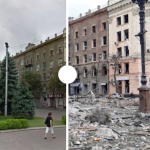The spectre of an incident at the Zaporizhzhia nuclear power plant has once again reared its head, as Russia stands accused of placing “explosive devices” on the roof.
So why are tensions over the nuclear facility escalating again? And if an explosion occurred at one or more of the reactors, how dangerous would it be?
Sky News spoke to a nuclear expert to investigate what is happening at Europe’s biggest nuclear power plant and what the level of risk is.
Kremlin denies China warned Putin – Ukraine war latest updates
What is the Zaporizhzhia plant and what has happened to it during the war?
The Zaporizhzhia facility features six nuclear reactors capable of generating around 1,000 megawatts of electricity each.
Most of the reactors at the Soviet-built power station were constructed in the 1980s, with unit 6 officially commissioned into service in 1996.
UK takes Iran to court over Ukrainian passenger jet shot down in 2020
Ukraine war: Why Russia’s statements about Zaporizhzhia nuclear plant are deeply worrying
Ukraine claims ‘explosive devices’ planted on roof of Zaporizhzhia nuclear facility
It is located near the city of Enerhodar, on the southern bank of the much-depleted Kakhovka Reservoir on the Dnipro river.
In nuclear power plants, electricity is generated through a process of nuclear fission – splitting uranium atoms – to make heat. This is used to boil water and create steam, which turns the turbines and generates electricity.
One of the 10 largest nuclear power stations in the world, the plant at one point generated nearly half of Ukraine’s nuclear power and more than 20% of the electricity generated in the country.
But now the plant’s reactors have been placed in shutdown for safety precautions and are no longer producing electricity.
In the early days of the 2022 invasion, as tanks rolled towards Kyiv in the north, Russian forces also advanced on the Zaporizhzhia plant in the south.
After heavy fighting – during which a fire broke out and a large calibre bullet pierced the outer wall of Reactor 4 – staff at the plant were told that it was now under the control of Rosatom, Russia’s state nuclear company.
Why are tensions over the nuclear facility ramping up?
Fears over safety at the Zaporizhzhia plant as a result of the ongoing war have endured, spiking at certain points due to changing circumstances and accusations from both sides.
This week, Russia and Ukraine accused each other of plotting to stage an attack on the power station.
Volodymyr Zelenskyy spoke of “dangerous provocations” at the plant, and his armed forces warned that “explosive devices” had been placed on the roof of reactors 3 and 4 on Tuesday.
“If detonated, they would not damage the reactors but would create an image of shelling from the Ukrainian side,” the military said on Telegram.
Meanwhile, Renat Karchaa, an adviser to the head of Rosenergoatom, which operates Russia’s nuclear network, said Ukraine planned to drop ammunition laced with nuclear waste transported from another of the country’s five nuclear stations on the plant. He offered no evidence in support of his allegation.
With unverified reports circulating that Russian forces are starting to leave the power plant, there are concerns that a similar scenario to the explosion at the Nova Kakhovka dam could occur.
Please use Chrome browser for a more accessible video player
Read more:
Why Russia’s statements about nuclear plant are worrying
Why Wagner boss remains a dangerous animal for Lukashenko
How dangerous would an explosion at the Zaporizhzhia be?
As Ukraine and Russia continue to accuse each other of planning to cause an explosion or other incident at the plant, it raises questions about what would happen if such a blast did occur.
Eugene Shwageraus, a professor of nuclear energy systems engineering at Cambridge University, told Sky News: “The installation is not built for housing troops and military equipment.
“Obviously, power plants are there to generate electricity and misuse of any industrial facility is a concern.”
But he added that nuclear power plants are built “pretty robustly” and said there was a difference between real dangers and perceived dangers.
Because the reactors were shut down months ago, Professor Shwageraus told Sky News, the most dangerous fission product that was being produced – Iodine-131 – has now decayed to safe levels.
Iodine-131 is important, he says, because it is both:
– volatile (very mobile in the environment), and
– dangerous to humans when encountered
But with the iodine from previous reactions now decayed to safe levels, the remaining isotopes of other elements that remain are not as much of a risk because they may be volatile or dangerous when encountered, but not both.
Asked if a large explosion at the plant would scatter any of the remaining radioactive materials further afield and thus present a problem, he replied: “A bit further means you will contaminate the parking lot of that power plant.”






















